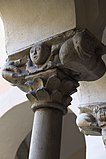Cloister of St. Peter and John the Baptist (Berchtesgaden)
The cloister of the former Augustinian canons of St. Peter and John the Baptist in Berchtesgaden in the Upper Bavarian district of Berchtesgadener Land is considered one of the most impressive Romanesque buildings in southern Germany. It was built from the late 12th century and, along with the step portal of today's parish and former collegiate church of St. Peter and John the Baptist, represents one of the oldest parts of the former monastery complex. The cloister is one of the protected architectural monuments in Bavaria.
history
The cloister was originally built for the Augustinian canons founded in 1102. Its origin is dated around 1180 to the middle of the 13th century. In 1559 the monastery was elevated to the status of a prince provost and expanded into a residence. In the course of secularization in 1803, the monastery was abolished and the Wittelsbachers set up their summer residence in the buildings. Like the other former monastery buildings, the cloister is now part of the building ensemble of the Royal Berchtesgaden Palace and is the property of the Wittelsbach Compensation Fund .
architecture
The cloister adjoins the former collegiate and current parish church of St. Peter and John the Baptist in the south. With the exception of the north wing, which was renewed around 1600, the Romanesque cloister has largely retained its original appearance. The no longer preserved fountain house stood on the south-west corner of the courtyard . The galleries are covered by groin vaults, which are reinforced by wide belt arches . The belt arches rest on corbels on the inner walls and on pilasters on the courtyard side .
Pillars and pillars
Arcades with three and four arches open to the inner courtyard , supported partly by columns and partly by pillars. The shafts of these supports are designed differently, they are round, square, octagonal, twisted or fluted.
Capitals and fighters
The capitals and spars are similar in shape to the pillars of the arcades . In addition to simple cube capitals, there are Corinthian capitals and those with leaf decoration. The fighters are decorated with imaginative ornaments, with figurative representations, animals and mythical creatures.
Relief representations
A pillar is provided with a relief representation of a mermaid , including a representation of a hybrid creature with a human head. One column shows the relief of a standing figure with long hair, who is holding a ball in his right hand. Another relief on the same column depicts a four-legged animal at the top and a person playing a lyre at the bottom, who is interpreted as Orpheus .
Tombstones
Numerous tombstones and epitaphs from the 14th to 16th centuries are embedded in the walls and floor of the cloister .
literature
- * Georg Dehio : Handbook of German Art Monuments. Bayern IV: Munich and Upper Bavaria . 2nd edition, Deutscher Kunstverlag, Munich 2002, ISBN 3-422-03010-7 , pp. 112-113.
- Gottfried Weber: The Romanesque in Upper Bavaria. Gondrom Verlag, Bindlach 1990, ISBN 3-8112-0703-2 , pp. 34-38.
Web links
Individual evidence
- ↑ List of monuments for Berchtesgaden (PDF) at the Bavarian State Office for the Preservation of Monuments, monument number DD-1-72-116-135
Coordinates: 47 ° 37 ′ 59 ″ N , 13 ° 0 ′ 17 ″ E
















